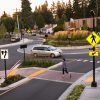Most drivers have had the heart-stopping experience of being forced to suddenly slam on the brakes to avoid an animal or an object entering their path without warning. Some have even had to brake or swerve to avoid hitting a pedestrian or cyclist.
It’s not a scenario anyone hopes to ever find themselves in, and fortunately, it’s one that can be largely avoided by providing adequate stopping sight distances at intersections, midblock crosswalks, trail, and railway crossings, and anywhere else a driver may be required to stop or yield.
In this article, we’ll explain what stopping sight distance is, how it’s calculated, and some things that can, quite literally, get in the way of it.
What is stopping sight distance?
For a driver to come to a safe stop ahead of an object or person, they need time to perceive, recognize, and react to it (the MUTCD calls this “Perception-Response Time” or PRT). According to the American Association of State Highway and Transportation Officials’ (AASHTO) Green Book, a widely-used industry resource that contains current street design research and best practices, stopping distance is defined as the sum of:
Reaction distance: The distance traveled by the vehicle from the instant the driver sees an object to the instant the brakes are applied.
plus
Braking distance: The distance traveled by the vehicle from the instant brake application begins to the instant the vehicle comes to a complete stop.
Taken together, they add up to the total distance required for a driver to perceive and react to an object in the roadway and to brake to a complete stop before reaching it.
How is it calculated?
There are several variables that go into calculating stopping sight distances, including perception-reaction time, driver eye height, object height, vehicle speed, roadway grade, and deceleration rate (i.e. how long it takes for a vehicle to come to a complete stop).
Fortunately, AASHTO has done much of the work of setting/recommending values for many of these variables and crunching the numbers. For example, perception-reaction time is typically set to 2.5 seconds, driver height at 3.5 feet above the roadway, and object height at 2 feet. Some state DOTs, however, have opted to do their own math, and have therefore arrived at (and adopted) slightly different standards.
The table below shows the recommended stopping sight distances provided by AASHTO (and endorsed by the FHWA).
| Vehicle speed (mph) | Stopping sight distance (feet) |
| 15 | 80 |
| 20 | 115 |
| 25 | 155 |
| 30 | 200 |
| 35 | 250 |
| 40 | 305 |
| 45 | 360 |
| 50 | 425 |
| 50 | 495 |
AASHTO’s stopping sight distance calculator
Note: The values listed above are also known as the design speed or design distance. They are typically set during the road design process to help determine the various geometric features. and may end up higher or lower depending on the roadway’s operating conditions.
Are there other factors to consider?
Yes! While the numbers above provide a good baseline, on some roadways, the added complexity of traffic, pedestrian activity, and other “visual clutter” may require longer distances. These factors are usually assessed during an engineering study, but here are a few to look out for:
- Horizontal and vertical curves. Whether your roadway involves steep inclines/declines or sharp turns, curves can have a big impact on the distance of the roadway ahead that’s visible to a driver. As curvatures increase, minimum stopping sight distances must also increase.
- Parked cars – On-street parking near crossing points can interfere with visibility. Parking restrictions or can help, allowing for clear sight lines between pedestrians and drivers. The FHWA recommends parking be restricted 50 feet from crossing points on roads with speed limits up to 35 mph, and 100 feet on roads with speed limits above 45 mph.
- Street furniture, lighting, landscaping, trash cans, and water fountains – While these things are important (and welcome!) pieces of the pedestrian landscape, they can be a hindrance to visibility when placed too close to a crossing. Any obstacle that can block visibility—for both drivers and pedestrians—should be removed or relocated.
Drivers’ ability to see the road ahead is critical to safe and efficient use of all roadway facilities but especially pedestrian crossings. Accurately calculating and implementing stopping sight distances goes a long way towards keeping both pedestrians and drivers safe.
Want to know more about crosswalk safety and the solutions we offer?
>>>Explore our walkability resources page
>>>Learn about our rectangular rapid flashing beacons (RRFBs) for crosswalks



